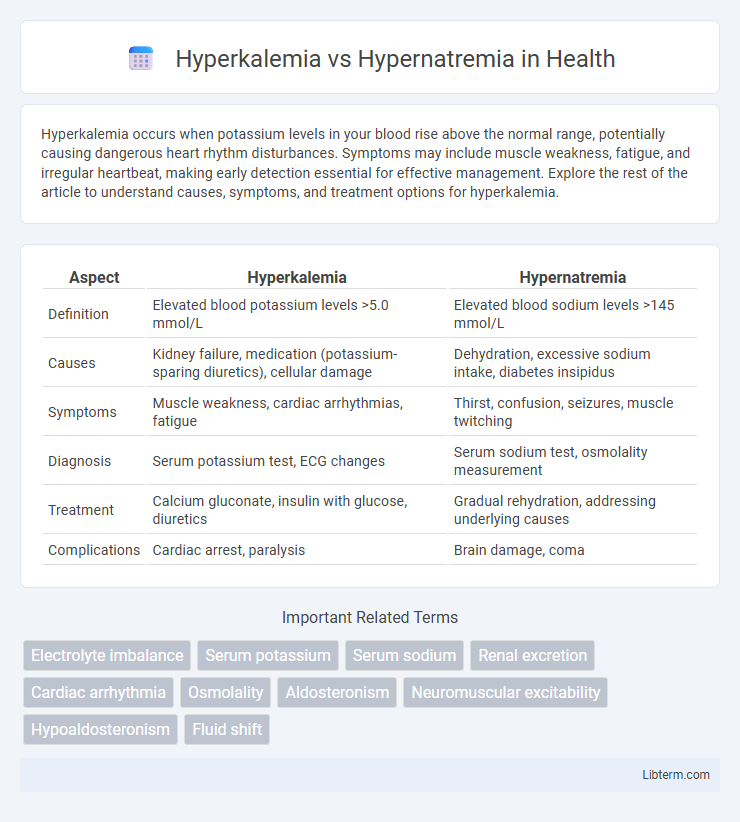Hyperkalemia occurs when potassium levels in your blood rise above the normal range, potentially causing dangerous heart rhythm disturbances. Symptoms may include muscle weakness, fatigue, and irregular heartbeat, making early detection essential for effective management. Explore the rest of the article to understand causes, symptoms, and treatment options for hyperkalemia.
Table of Comparison
| Aspect | Hyperkalemia | Hypernatremia |
|---|---|---|
| Definition | Elevated blood potassium levels >5.0 mmol/L | Elevated blood sodium levels >145 mmol/L |
| Causes | Kidney failure, medication (potassium-sparing diuretics), cellular damage | Dehydration, excessive sodium intake, diabetes insipidus |
| Symptoms | Muscle weakness, cardiac arrhythmias, fatigue | Thirst, confusion, seizures, muscle twitching |
| Diagnosis | Serum potassium test, ECG changes | Serum sodium test, osmolality measurement |
| Treatment | Calcium gluconate, insulin with glucose, diuretics | Gradual rehydration, addressing underlying causes |
| Complications | Cardiac arrest, paralysis | Brain damage, coma |
Introduction to Electrolyte Imbalances
Hyperkalemia and hypernatremia represent critical electrolyte imbalances characterized by elevated potassium and sodium levels respectively in the bloodstream, impacting cellular function and fluid balance. Hyperkalemia is often linked to impaired renal excretion, cellular injury, or acidosis, resulting in potential cardiac arrhythmias and muscle weakness. Hypernatremia typically arises from water loss or sodium gain, causing cellular dehydration, neurological symptoms, and severe complications if untreated.
What is Hyperkalemia?
Hyperkalemia is a medical condition characterized by abnormally high levels of potassium in the blood, typically above 5.0 mmol/L. It disrupts normal cellular function, leading to symptoms such as muscle weakness, fatigue, and potentially life-threatening cardiac arrhythmias. Unlike hypernatremia, which involves elevated sodium levels, hyperkalemia primarily affects the heart's electrical activity and requires prompt medical intervention to restore electrolyte balance.
What is Hypernatremia?
Hypernatremia is a medical condition characterized by an elevated sodium concentration in the blood, typically above 145 mEq/L, resulting from water loss or excessive sodium intake. It primarily causes cellular dehydration, leading to neurological symptoms such as confusion, seizures, and muscle twitching. Diagnosing hypernatremia involves measuring serum sodium levels and assessing underlying causes like dehydration, kidney dysfunction, or hyperaldosteronism.
Causes of Hyperkalemia
Hyperkalemia primarily results from impaired renal excretion due to acute or chronic kidney disease, medications such as potassium-sparing diuretics or ACE inhibitors, and cellular shifts caused by conditions like metabolic acidosis or tissue breakdown in rhabdomyolysis. Excessive potassium intake is a less common cause but can exacerbate hyperkalemia in predisposed individuals. Understanding these causes is essential for differentiating hyperkalemia from hypernatremia, which predominantly arises from water loss or sodium gain rather than potassium dysregulation.
Causes of Hypernatremia
Hypernatremia primarily results from water loss exceeding sodium loss, often caused by dehydration, diabetes insipidus, or excessive salt intake. Conditions such as diarrhea, excessive sweating, or inadequate water consumption disrupt the balance of body fluids, leading to elevated sodium levels. The kidneys' impaired ability to conserve water or hormonal imbalances involving antidiuretic hormone also contribute significantly to hypernatremia.
Symptoms: Hyperkalemia vs Hypernatremia
Hyperkalemia symptoms often include muscle weakness, fatigue, palpitations, and in severe cases, cardiac arrhythmias due to elevated potassium levels. Hypernatremia presents with symptoms such as intense thirst, confusion, seizures, and neuromuscular irritability resulting from increased sodium concentration. Differentiating these electrolyte imbalances clinically is crucial, as hyperkalemia primarily disrupts cardiac and muscular function while hypernatremia affects neurological status.
Diagnostic Criteria and Laboratory Findings
Hyperkalemia is characterized by serum potassium levels exceeding 5.0 mmol/L, often confirmed through elevated plasma potassium measurements and changes in electrocardiogram (ECG) such as peaked T waves and widened QRS complexes. Hypernatremia is defined by serum sodium levels above 145 mmol/L, identified through hyperosmolarity on laboratory tests and clinical signs like decreased urine osmolality, indicating water deficit rather than sodium excess. Both conditions require precise laboratory assessment of electrolytes, with hyperkalemia often linked to renal dysfunction or cellular breakdown and hypernatremia commonly associated with dehydration or impaired water intake.
Treatment Strategies for Hyperkalemia
Treatment strategies for hyperkalemia prioritize stabilizing cardiac membranes using intravenous calcium gluconate, followed by shifting potassium intracellularly with insulin and glucose administration, and enhancing removal through diuretics, sodium polystyrene sulfonate, or dialysis in severe cases. Continuous monitoring of serum potassium levels and electrocardiogram changes is essential to prevent life-threatening arrhythmias. Hypernatremia treatment contrasts by focusing on gradual free water replacement and addressing underlying causes rather than rapid potassium modulation.
Treatment Approaches for Hypernatremia
Treatment approaches for hypernatremia primarily focus on gradual correction of serum sodium levels through controlled administration of hypotonic fluids such as intravenous 5% dextrose or half-normal saline to avoid rapid shifts causing cerebral edema. Careful monitoring of fluid balance, serum electrolytes, and neurologic status is essential during therapy. Addressing underlying causes like dehydration or diabetes insipidus optimizes patient outcomes and prevents recurrence.
Prevention and Prognosis
Effective prevention of hyperkalemia centers on managing underlying conditions such as chronic kidney disease and avoiding excessive potassium intake, while monitoring medications like ACE inhibitors that increase potassium levels. Preventing hypernatremia involves ensuring adequate water intake, especially in vulnerable populations like the elderly or those with impaired thirst mechanisms, and careful management of sodium-rich intravenous fluids. Prognosis for hyperkalemia significantly improves with timely intervention to prevent cardiac arrhythmias, whereas hypernatremia prognosis depends on rapid correction of fluid imbalances to avoid neurological complications.
Hyperkalemia Infographic

 libterm.com
libterm.com